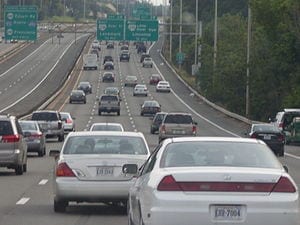Future research projects include optimized routing, road hazard reporting, optimized de-icing, beacon for at-risk pedestrians, and vehicle-to-vehicle communication to enhance rear signaling.
Someday, your auto and the roadway will be in constant communication and able to suggest route changes to avoid accidents, construction, and congestion; coordinate your vehicle with signal lights, other vehicles, and lane markers; and let you know where you can park. Right now, a fleet of instrumented vehicles are testing these systems on two instrumented test beds – one in Northern Virginia and one in Southwestern Virginia.
The test beds are being operated by the Connected Vehicle/Infrastructure University Transportation Center, a Tier 1 University Transportation Center operated by a consortium made up of the Virginia Tech Transportation Institute, the University of Virginia’s Center for Transportation Studies, and Morgan State University. Robust vehicle-to-vehicle, vehicle-to-infrastructure, and vehicle-to-device communication will enable applications addressing the U.S. Department of Transportation’s strategic goals of safety, state of good repair, economic competitiveness, livable communities, and environmental sustainability.
In Northern Virginia, as you speed along Interstate 66 in Fairfax County, or move hopefully more sedately along Routes 29 and 50, you may notice large metal boxes with egg-beater like antenna along the sides of the roads.
“The Northern Virginia test bed is a tremendous asset with respect to testing and deployment of research findings,” said Center Director Tom Dingus, who is also director of the Virginia Tech Transportation Institute. “Key elements of this test bed are strong partnerships with local agencies, including law enforcement and transit providers, particularly the Fairfax County Transit Authority.”
“The Fairfax County test bed experiences the very real and significant transportation challenges in terms of congestion, safety, and environmental impact that are of concern nationwide,” said University of Virginia Consortium Leader Brian Smith, professor and chair of the department of civil and environmental engineering. “Through this test bed, our research team will have the opportunity to develop, test, and demonstrate tangible connected vehicles applications that will have a positive impact on the travelers’ experience.”
Southwest Virginia test bed resources include Route 460 in Montgomery County, for real-world testing as in Northern Virginia, and Virginia’s Smart Road, a closed circuit transportation research facility in Blacksburg where experimental procedures can be tested.
“The test beds provide a variety of roadway types, topography, and driver types that allow us to exercise connected-vehicle systems across a range of environments under controlled conditions, so that a high number of equipped vehicle interactions will occur,” said Morgan State Consortium Leader Andrew Farkas, professor and director of the National Transportation Center.
The 55 roadside units report road hazards, optimize de-icing operations, warn of congestion and emergency vehicles, and monitor pavement condition. The instrumented vehicles, which include 10 cars, a semi-truck, and a bus, have forward-collision, road-departure, blind-spot, lane-change, and curve-speed warning system and advance geographic information systems. They also have sophisticated recording devices that download to the University Transportation Center so that researchers can observe in real-time and accumulate data for later transportation.
via Virgina Tech
The Latest Streaming News: New transportation communication systems updated minute-by-minute
Bookmark this page and come back often
Latest NEWS
Latest VIDEO









